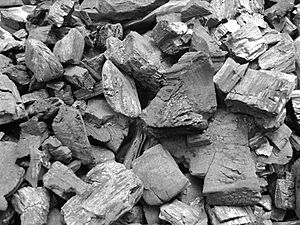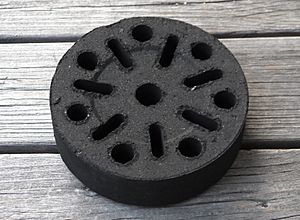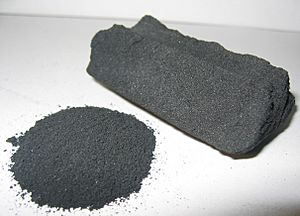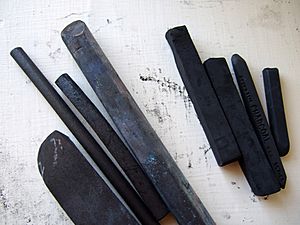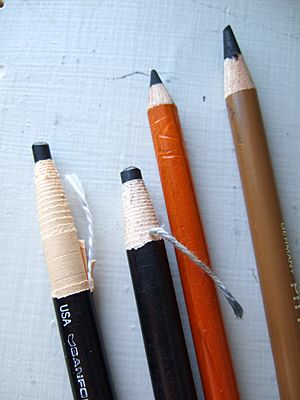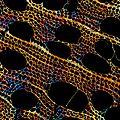Charcoal facts for kids
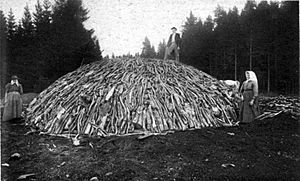
Charcoal is a light, black material made mostly of carbon. It's what's left after you heat wood or other plant stuff without much oxygen. This process is called pyrolysis.
Most charcoal isn't pure carbon because it has some ash. But charcoal made from sugar can be very pure. This is especially true if it's made using a chemical reaction instead of just heat. The final product is soft, light, black, and full of tiny holes, looking a bit like coal.
Contents
Uses of Charcoal
People have used charcoal for a very long time for many things, like art and even medicine. But its most important use has always been as a fuel for working with metals. It's the classic fuel for a blacksmith's forge and other jobs that need really hot fires.
Historically, charcoal was ground into a fine powder called carbon black. This was important for early chemists and was used in things like Black Powder. Because charcoal has a lot of tiny holes, it can also be used as a filter or to absorb things.
Fuel for Metals
Charcoal burns at very high temperatures, up to 2700 degrees Celsius. To compare, iron melts at about 1200 to 1550 degrees Celsius. Because charcoal is porous (full of tiny holes), you can control how hot it burns by changing the airflow. This makes it perfect for a forge, and blacksmiths still use it widely.
Charcoal has also been used since Roman times to help make iron. In the 16th century, England even had to make laws to stop too many trees from being cut down for charcoal production. In the 1800s, coke (a type of baked coal) mostly replaced charcoal for making steel because it was cheaper. However, charcoal is a better fuel than coke because it burns hotter and doesn't have sulfur.
Even until World War II, Sweden used charcoal to make very high-quality steel. Some experts believe that in steel-making, charcoal not only acts as a fuel but also adds carbon to the steel itself.
After a big climate change meeting in 2009, Brazil's steel industry suggested using charcoal instead of coal and coke. They started a program to turn wood from special tree farms into charcoal for steel making. This is part of making "Green Steel."
Industrial Fuel
In the past, huge amounts of charcoal were used to melt iron in early furnaces. This use was replaced by coke during the Industrial Revolution.
More recently, in 2010, Japan looked for a "greener" and cheaper fuel than fossil fuels for steelmaking. They found that charcoal made from Palm Kernel Shells works better than coke in Electric arc furnaces (EAFs).
Cooking Fuel
Before the Industrial Revolution, charcoal was sometimes used for cooking. Today, modern "charcoal briquettes" are popular for outdoor grilling and barbecues. These briquettes are not pure charcoal. They are usually pressed mixtures of sawdust with other things like coal or coke and binders.
Fuel for Vehicles
Charcoal can be used to make a gas called syngas. This gas can be used as fuel, even for cars.
When gasoline was hard to find, like during wars, cars and buses were changed to run on "wood gas." This gas is made by burning charcoal or wood in a special generator. In 1931, a Chinese inventor named Tang Zhongming created a charcoal-powered car. These cars were popular in China until the 1950s. During World War II, France greatly increased its production of wood and charcoal for these vehicles.
Black Powder
Charcoal is a key ingredient in Black Powder and other explosive mixtures. For this, charcoal is usually made from softwoods like willow or grapevine, heated at a low temperature.
Carbon Source
Charcoal can be used as a source of carbon in chemical reactions. For example, it's used to make carbon disulfide by reacting sulfur with hot charcoal.
Purification and Filtration
Charcoal can be "activated" to make it an even better filter. Activated charcoal is very good at absorbing many different substances dissolved in gases and liquids. For instance, it can remove unwanted colors when purifying sugar.
It's also used to absorb bad odors and harmful substances in the air. Charcoal filters are found in some gas masks. In medicine, activated charcoal is mainly used to absorb poisons. You can buy activated charcoal without a prescription. It's often used to help with gas in the digestive system.
Art
Charcoal is a popular tool for drawing and making quick sketches for painting. Artists use charcoal in three main forms:
- Vine charcoal is made by burning sticks of wood (like willow). It comes in soft, medium, and hard types.
- Powdered charcoal is used to cover large areas of a drawing surface. You can draw over these areas to make them darker or erase parts to make them lighter.
- Compressed charcoal is charcoal powder mixed with a binder. This mixture is pressed into round or square sticks. The amount of binder changes how hard the stick is. Compressed charcoal is also used in charcoal pencils.
Gardening
Charcoal has a rediscovered use in horticulture (gardening). Gardeners in America have used charcoal for a while. Research on special soils in the Amazon, called Terra preta, found that ancient people used biochar (a type of charcoal) to turn poor soil into rich, carbon-filled soil. This technique might be used today to improve soils and help store carbon.
Medicine
In the past, people ate charcoal biscuits for stomach problems. Today, charcoal can be taken as tablets, capsules, or powder for digestive issues. However, scientists are still debating how effective it is.
Red colobus monkeys in Africa have been seen eating charcoal to help themselves. Their leafy diet has a lot of cyanide, which can cause indigestion. So, they learned to eat charcoal, which absorbs the cyanide and helps their stomachs. This knowledge is passed down from mother to baby monkeys.
You can learn more about its medical uses at Activated charcoal, medicinal applications.
Environmental Concerns
Making charcoal on a small scale is one reason for deforestation (cutting down too many trees). Often, charcoal production is not regulated. For example, in Brazil, it's a big illegal industry for making pig iron.
Massive forest destruction has happened in places like Virunga National Park in the Democratic Republic of the Congo, where it threatens mountain gorillas. Similar problems are seen in Zambia. In Malawi, illegal charcoal trade employs many people and is the main source of heat and cooking fuel for most of the country.
Some experts, like Duncan MacQueen from the International Institute for Environment and Development (IIED), argue that while illegal charcoal production causes deforestation, a regulated charcoal industry that replants trees could provide clean energy and help the environment.
Images for kids
-
Binchōtan, Japanese high grade charcoal made from ubame oak
See also
 In Spanish: Carbón vegetal para niños
In Spanish: Carbón vegetal para niños


